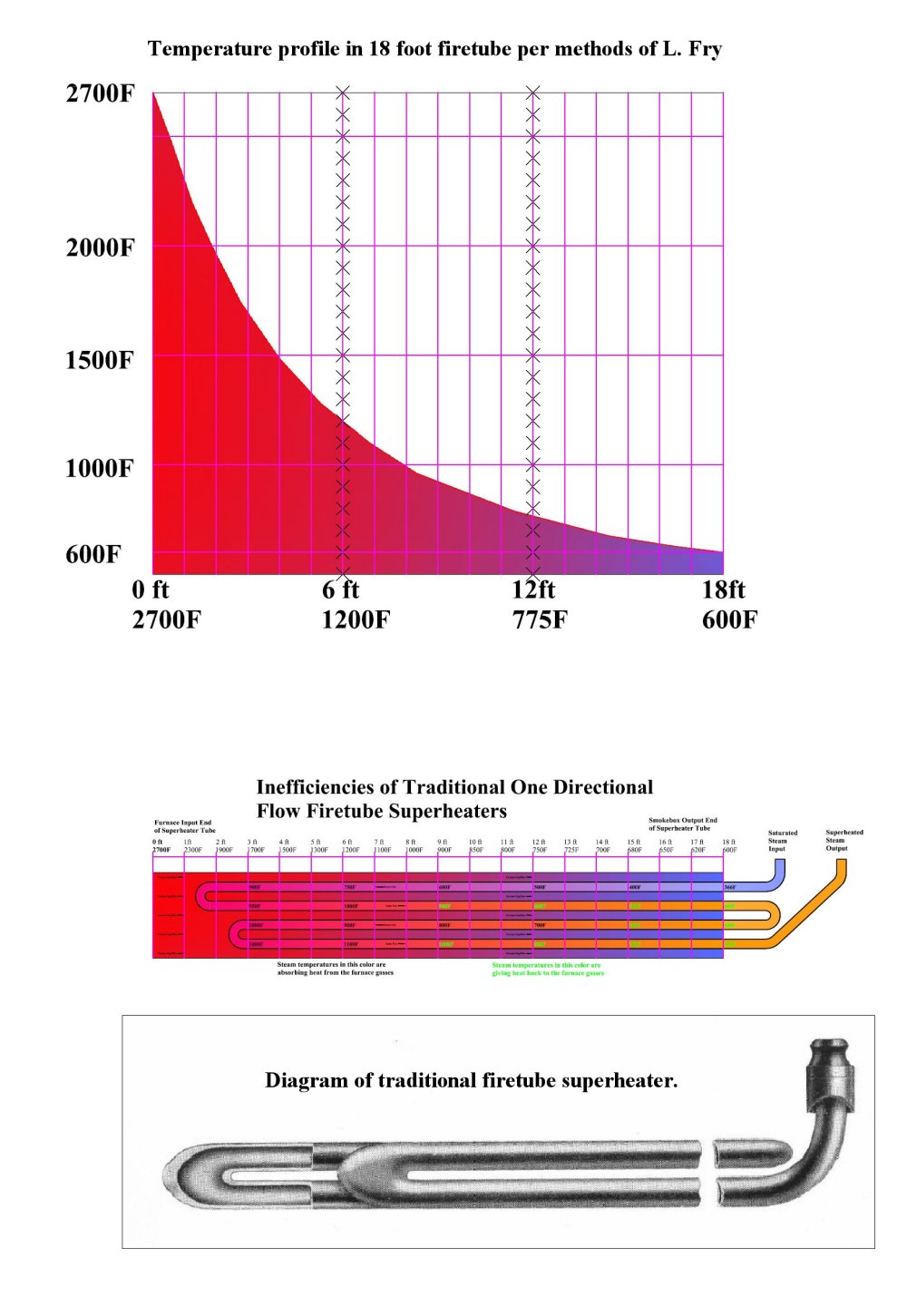
Invention of Firetube Steam Superheater
An annular superheater has been invented that allows for existing firetube package boilers to be retrofitted with integral superheater elements that increase the steam temperature without increasing the steam pressure. For more than 120 years, attempts to install integral superheaters have all failed. Industry experience insists that integral superheaters are not practical in firetube package boilers.
The AA Superheater Co. design is covered by patents in the United States, Canada, India and Great Britain. Patents are pending in China.
Patents Issued for the AA Superheater Invention
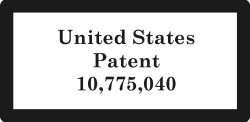




Thermal Energy Advantages of Superheated Steam
(See Example)
Heat flow across a boundary is not just faster with a higher heat differential, but exponentially faster. In industrial processes, such as cooking, laundry drying, chemical processing, etc., using superheated steam heat can provide measurably shorter process times. It still takes the same number of BTUs to complete the process, but 10%, 20% or 30% less time manifests savings in many ways.
A major supplier of industrial laundry drying and ironing equipment provides a line of flatwork ironers designed for use of saturated steam at 150 psi or thermal fluid oil operating at 650°F. Use of the 650°F thermal oil allows the advertised throughput capacity to be increased by 50%.
Boiler and generator output can be scaled to suit the factory size. Integral superheaters installed in a firetube boiler makes a practical application of electrical generation as a value added process between the boiler room and the process plant. A 350 psi superheated firetube boiler feeding a steam turbine electric generator will exhaust process steam at 100 psi at 570°F.
Package Firetube Boilers
As steam became the predominate means of energy transmission before 1900, firetube boilers were the first mass produced style with a practical operating pressure limit of about 150 psi. Factories would have 10 to 20 boilers installed in steel frame brick settings to generate the amount of steam required. Beginning about 1910, the ever increasing demand for higher pressures and superheated steam lead to development of watertube style boilers. After WW2, the boiler manufacturing industry began to standardize smaller firetube boilers as pre-piped, skid mounted units sold as a "package". The boilers were equipped with all the standard appurtenances such that only electric, fuel and water hook ups were required. Because of the mass production/assembly line manufacturing technique of package firetube boilers, costs of package boilers are typically 20% - 40% less than comparable watertube style boilers. The industry established terms such as Boiler Horse Power(BHP) in comparing steam generating capacity between different brands and models. There are currently about 100,000 package firetube boilers operating in the US with a capacity of 36,000,000 BHP. About 1000 boilers are manufactured annually representing about 300,000 BHP.
Patents appear around 1900 for superheaters applicable to boilers. In that era, boilers were typically of the firetube configuration. Before arc welding, boilers were manufactured using riveting, forging and threaded construction. Tubes for boilers were predominately wrought iron instead of steel into the 1920s. It should be noted that each decade in the first half of the 20th Century brought quantum leaps in technology. Higher pressures brought watertube boilers into prominance in the 1920s, however, firetube boilers for railroad locomotives continued development until the end of the 1940s. After WW2, factory assembled "pacakaged boilers" became the norm for commercial size boilers while field assembled watertube boilers continued to dominate the industrial sector of industry. The last steam locomotives for US railroads were manufactured in 1949.
The principle of "packaged boilers" drove the design and construction in the direction of uniformity and simplicity. This precluded the adoption of the highly refined locomotive type superheaters in the package boiler market. The complexity and maintenance expertise required did not justify the efficiencies of superheat in the commercial segment of industry.
Why AA Superheaters Will Be Successful
- A prodigious Engineer named Lawford Fry quantified heat transfer quantities and temperature profiles in boiler firetubes and published his findings in the ASME Transactions beginning in the early 1900s. ( Engineer, Baldwin Locomotive Works, 1897-1913. Metallurgical engineer, Standard Steel Works, 1913-1930. Railway engineer, Edgewater Steel Company, 1930-1943.)
Mr. Fry derived the equations with "just a pencil and a slide rule" while sitting in his hotel room at night on business trips using Steam Locomotive Test Plant Data. His equations accurately married the test plant data +/-5%. His contemporaries however, claimed his equations were "barbarous". The logarithmic mean temperature difference used today is a dumbed down approximation of Mr. Fry's equations. Mr. Fry's equations indicate that a 3" difference in location in the firetube can cause a 50F difference in final superheat output temperatures. - In the 1920s and 30s, boiler industry engineers had 2 conflicting fundamentals. The first was boiler/superheater capacity was dependent on surface area and dwell time. The other was that higher flow velocities increased heat transfer rates. It was determined during the time of WW2 that the earlier locomotive superheater version of the 1920s met the demands of locomotive superheat using much simpler and cheaper methods and maintenance, although inefficient as described below. Even the simpler version of the locomotive superheater contradicts the simplicity principle of package boilers.
- The current invention simultaneously solves five issues that were not addressed in previously granted patents for annular firetube superheaters.
Secrets of AA Superheaters
-
AA Superheaters are designed using unitized modular construction for ease in installation and maintenance.
-
AA Superheaters are designed using annular flow. The heat flux is always from higher temperatures to lower temperatures, in the direction of lower temperature steam.
-
Velocity flow rates are the highest practical to take advantage of higher heat transfer rates.
-
Velocity pressure on the endcap at designed flow rates is deceivingly high. The nominal force on the endcap due to boiler pressure is about 200 lb-f. The force due to velocity pressure of the steam making a 180 degree turn is about 2000 lb-f.
- The PATENTED SECRET to the success and reliability of the AA Superheater is to design and manufacture the endcap for what it really is: a high velocity steam turbine nozzle and turbine blade. The materials used must be similar to those used for steam turbine blades and nozzles at the temperatures seen in superheater service. Such materials are available in forms certified for ASME service.
History of Firetube Superheaters
The first practical firetube superheater was patented in 1912. The intended application was in steam locomotive boilers. Tests proved that thermodynamic efficiency could be improved up to 30%. Fuel consumption could be reduced 30% for the same load, or 30% more tons of freight could be pulled for the same fuel. There was an impediment to its success. In the existing technology of the era, welding was not viable. The return bends were threaded cast steel that were not reliable in rigorous locomotive service. In 1916, a forging process was patented whereby a single return bend was forged from two tubes. This supplied the reliability required. By 1919, three thousand locomotives a year were being manufactured and most locomotives built since 1900 were being retro-fitted with superheaters. Steam was superheated in a firetube boiler by adding larger size firetubes in the tube bundle and populating these "superheater flues" with small diameter tubing elements where the steam flows from the low gas temperature exit end of the firetube toward the high gas temperature furnace end of the firetube. The superheater element tubing has a 180 degree return bend that reverses the flow to send the now superheated steam out of the boiler. Because the traditional firetube superheater requires 2 tubing elements occupying a larger diameter firetube, there are inherent inefficiencies in the heat transfer. Temperature profile is derived using the methods derived by Lawford Fry.
Application of Superheat to Firetube Package Boilers
A moderate size chemical or food processing plant will use about 1500 BHP of steam generating capacity, typically at 100 psi pressure with a temperature of about 338°F. With the retrofit of a practical superheater to an existing boiler, steam with a temperature of 650°F can be produced and sent to the plant. Higher steam temperature will allow for exponentially increased heat transfer rates in production machinery. Production rate increase will vary by equipment and process but should be in the 10% to 30% range.
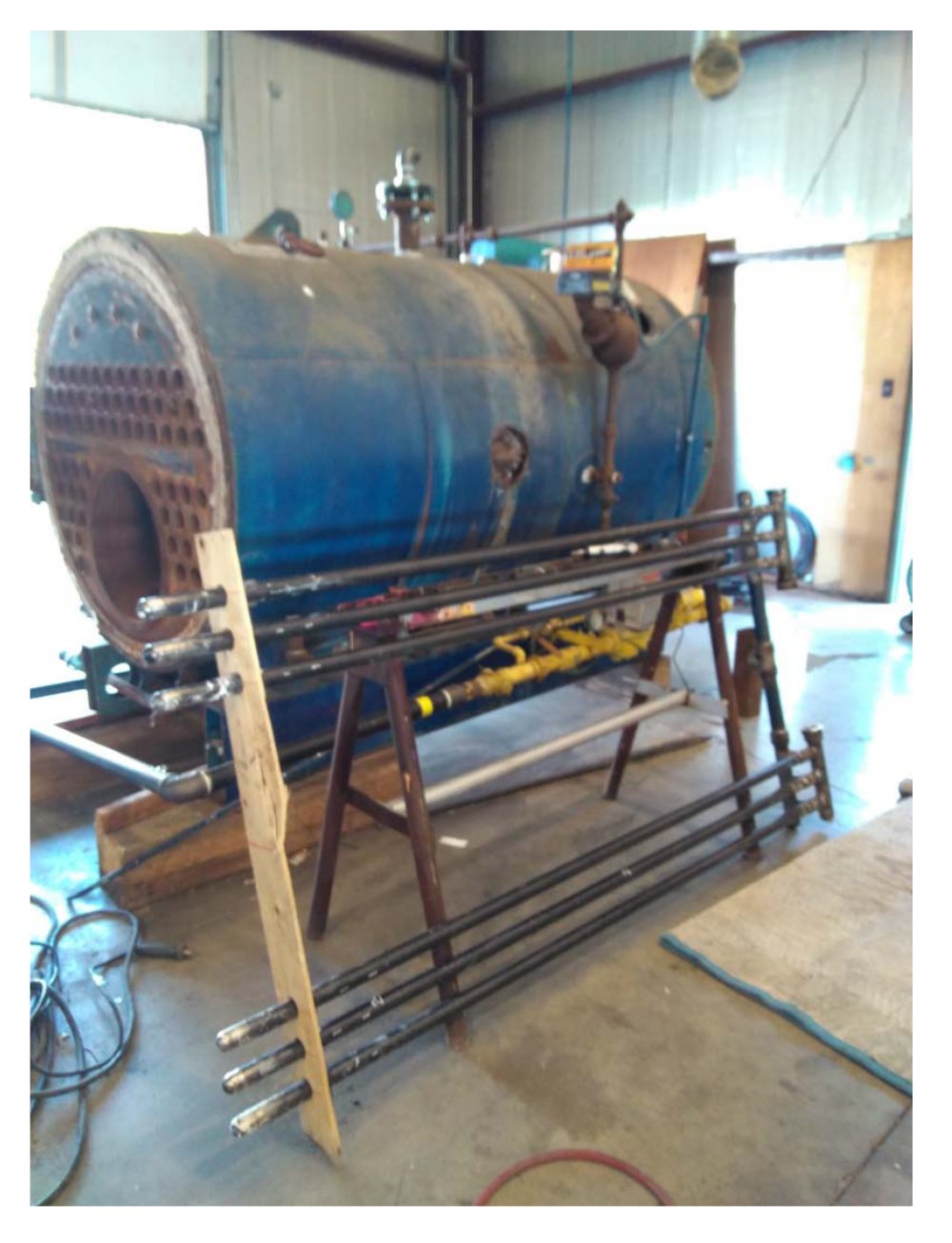
Prototype AA Superheater for 60 BHP package boiler before installation
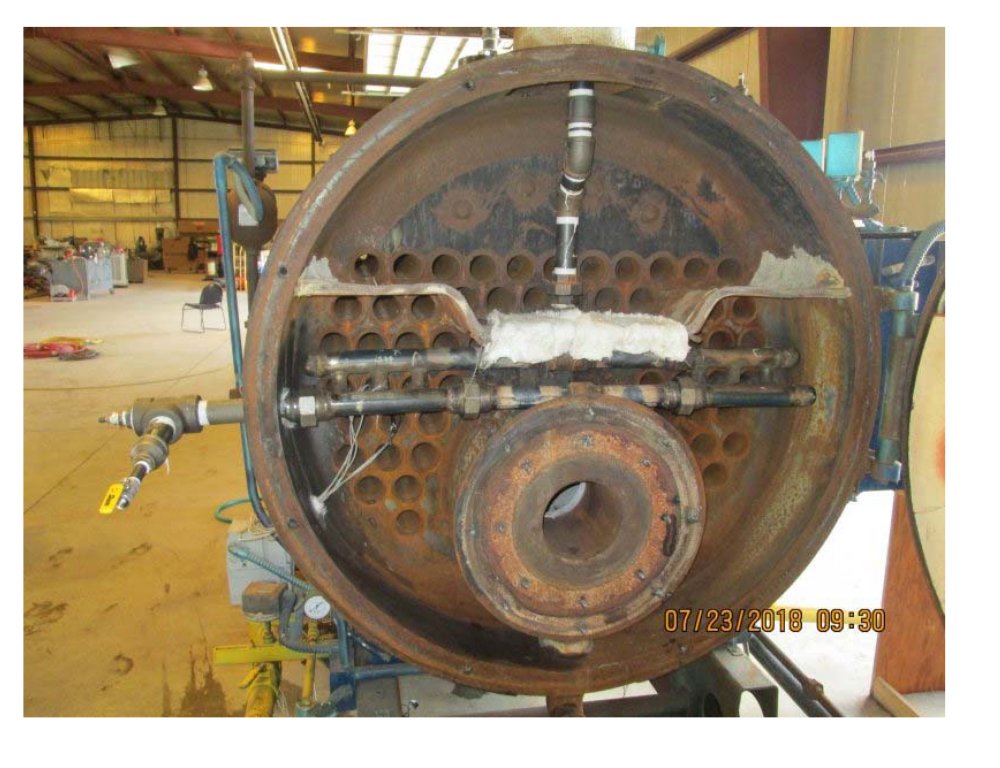
Prototype AA Superheater for 60 BHP package boiler installed
AA Superheater Test
TEST DATA: It was discovered after the test that the 500 gallon propane tank at the location was choke limited to provide 1.25 MM BTU/hr. The 60 BHP boiler was expecting 2.5MM BTU per hour. This explains the temperature plateau at about 1100F at 50% firing rate.
Furnace gas temperature at 100% firing rate was expected to be 2100F. As shown the furnace gas temperatures matched the end cap temperatures very closely. At higher firing rates the furnace gas temperatures will increase, however, the steam flow rates will also increase. Higher temperatures and higher flow rates BOTH INCREASE the heat flow rates across the superheater tubing wall. It is predicted that the end cap maximum temperature will settle in the 1400F to 1500F range. The higher end cap temperatures than furnace gas temperatures is attributed to radiant heat adsorption from the back refractory wall.
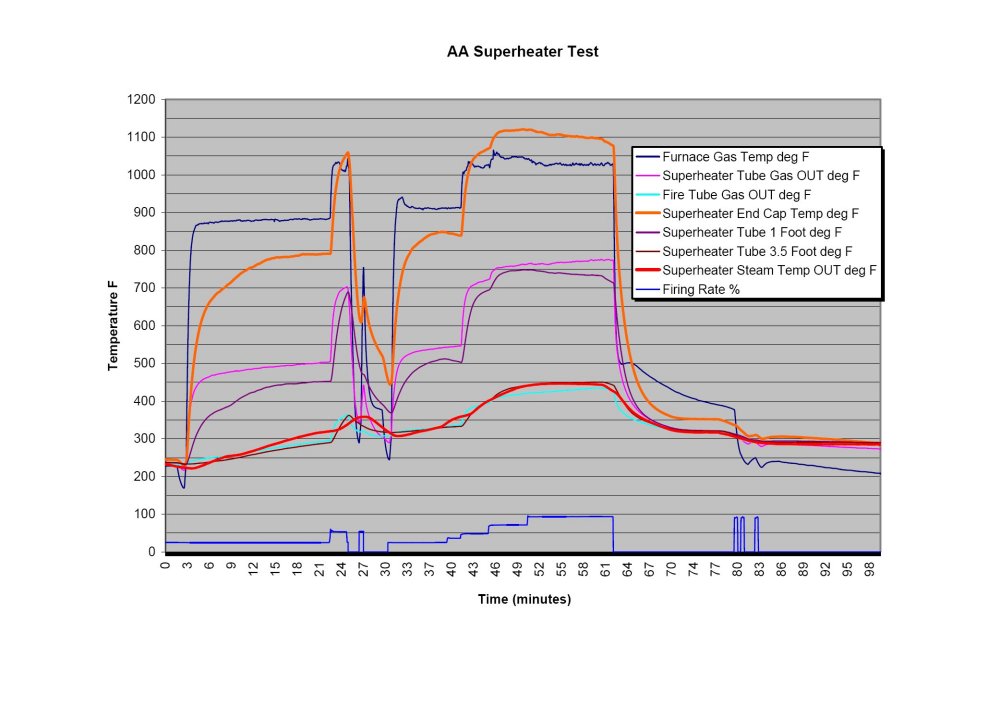
- Time Event
- 0" Boiler pressure 100 psi. Full water.
- 0-3" Boiler purge.
- 3" Main flame ignition firing rate 25%.
- 22" Firing rate increased to 50%.
- 25-30" Gasket failure and high pressure reducing valve.
- 31" Gasket replaced. Boiler restart firing rate 25%.
- 31-39" Firing rate 25%. Temps stabilize.
- 42" Firing rate 50%.
- 46" Firing rate 75%.
- 51" Firing rate 100%.
- 62" Firing rate 0%. Boiler off.
- 80" Boiler purge. One minute.
- 81" Boiler purge. One minute.
- 83" Boiler purge. One minute.
Test Trace Legend (Firetube length 7'. End Cap located 1" inside firetube.)
- 1. Furnace Gas Temp - Temp at entrance to first pass firetubes.
- 2. Superheater Tube Gas OUT - Temp at outlet of firetube with element.
- 3. Fire Tube Gas OUT - Temp at exit of firetube without element.
- 4. Superheater End Cap - Temp of End Cap
- 5. Superheater Tube 1 Foot - Superheater Tube Temp One Foot from End Cap.
- 6. Superheater Tube 3.5 Foot - Superheater Tube Temp 3.5 Feet from End Cap.
- 7. Superheater Steam Temp OUT - Superheater Tube Temp at boiler steam output.
- 8. Firing Rate Percent - Control signal to firing valve motor.
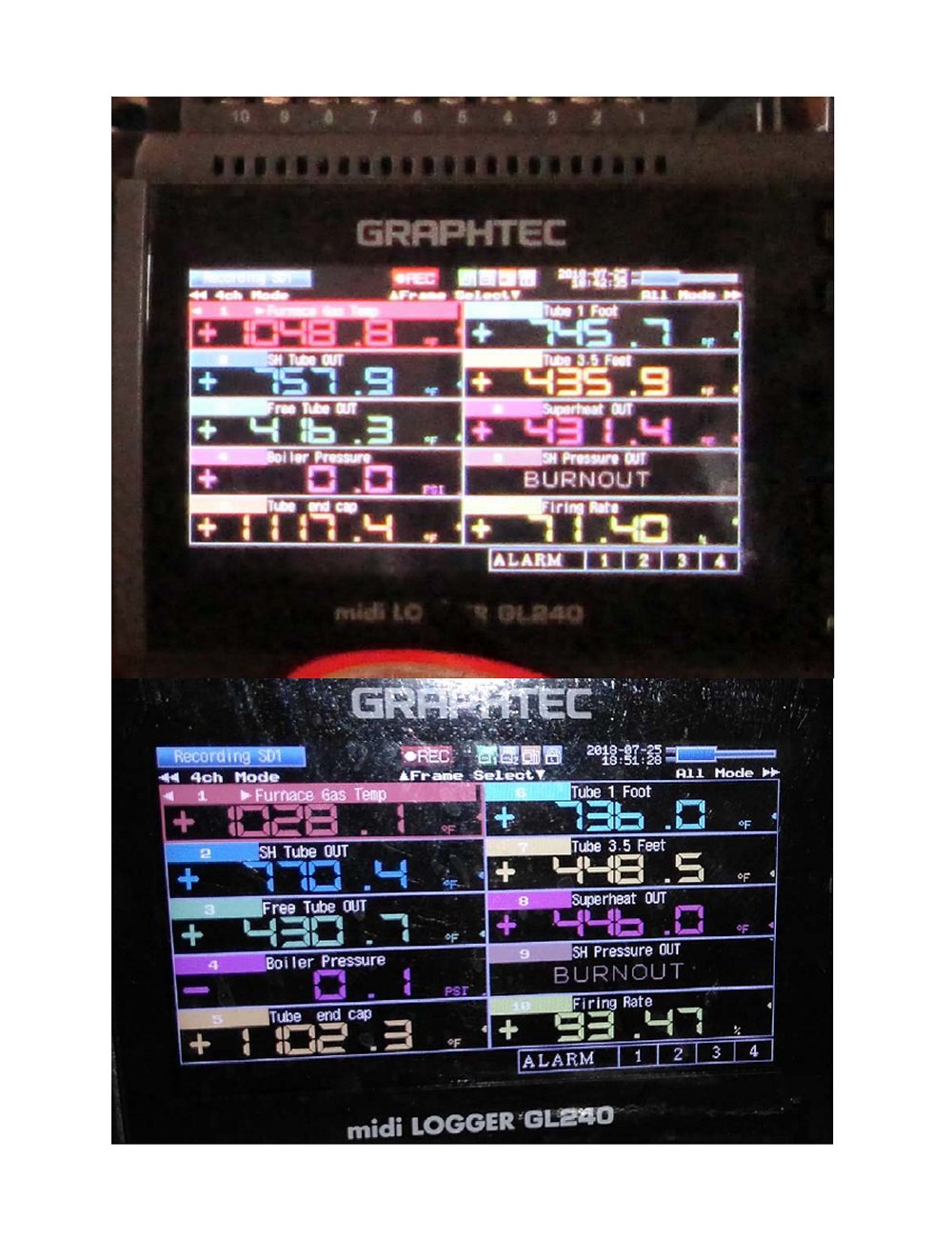
Electrical Generation with Superheated Steam
Perhaps the most effective and profitable application of superheated steam from a package boiler is the ability to generate and sell significant electricity with minimal investment and astronomical payback rates. A 1500 BHP package firetube boiler designed to operate at 350 psi can be equipped with a superheater making 750°F steam. Steam at this pressure and temperature can then be sent through a one megawatt turbine and will exhaust steam at 100 psi and 570°F. With no other alterations to the plant, except the installation of a high pressure superheater equipped package boiler and a steam turbine, one megawatt of electricity can be generated in addition to moderate superheat supplied to the plant as process steam. The value of one megawatt-year of electricity at 10¢/kWhr is $876,000.00. Currently, typical electricity rates in the US vary for 10¢ to 20¢ per kilowatt-Hour. Cost for such an installation would be about $2.25M.
AA Superheater Co., Inc. is poised to begin production
Please click this link for information on startup investment opportunities.
Contact:
AA Superheater Company, Inc.
Corporate Address:
1712 Pioneer Ave. Ste 2285
Cheyenne, WY 82001
Website: www.AASuperheater.com
Email: MAustin@AASuperheater.com
Ph. 404-737-8663


